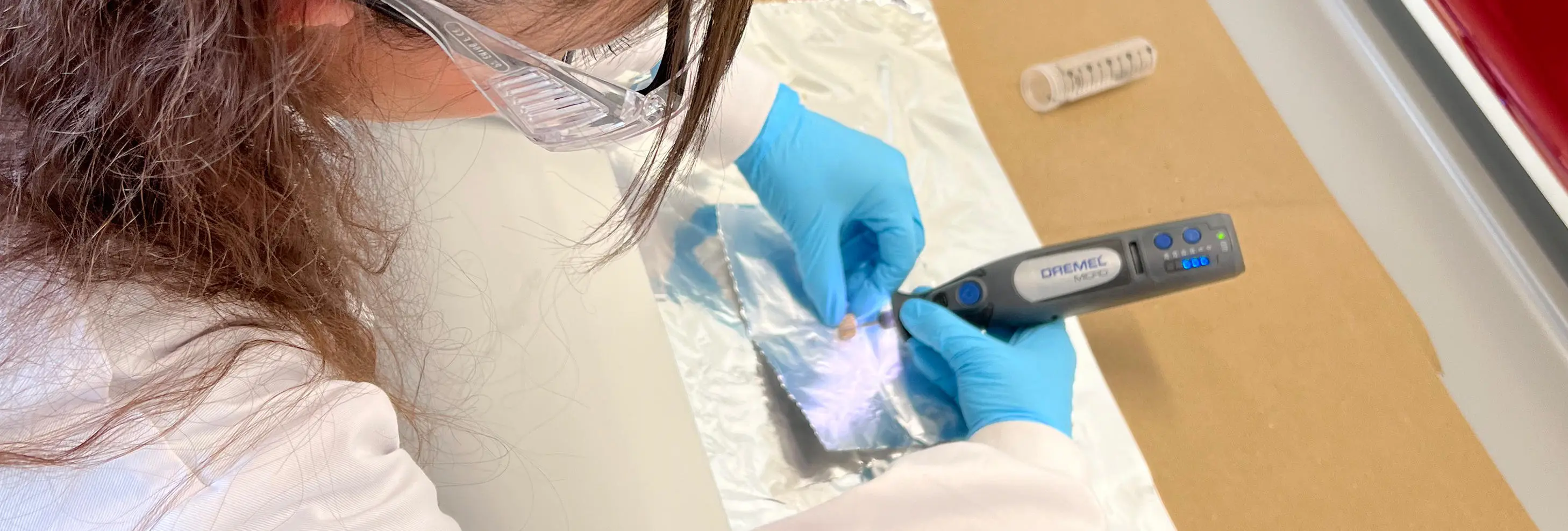Cutting-edge science being applied to human bones could help provide vital clues for the police and archaeologists alike
Scientists at the University of Central Lancashire (UCLan) are working on applying some of the most cutting-edge technologies to human bones, which could answer two incredibly important questions for those working to solve crimes involving human remains: when did a person die, and what was their age at the time of death?
This information is notoriously difficult to establish definitively, and current estimations around a time and age of death tend to be subjective, relying on the expertise and opinion of the individual forensic scientist that performs the analysis.
What’s more, most of the techniques developed so far to estimate the post-mortem interval of victims – the time elapsed from their death – rely on evaluations performed on soft tissues. However, these are only present for a short period after death – so if the victim is found months or years later, these tissues have often disappeared.
Meanwhile, techniques aimed at establishing the age-at-death of the victim, often rely on the completeness of the skeleton to look for specific structural traits that can point towards the chronological age of the person. But again, if only some bones are recovered, as is often the case for cold cases victims - or those involved in natural disasters, terrorist attacks, or archaeological excavations - then it is very difficult to get a complete and accurate picture.
"We’re applying some of the most cutting-edge technologies available in modern biology and biochemistry laboratories – it’s a new way of doing things, and we’re calling it ‘Forens-OMICS’."
— Dr Noemi Procopio, a Senior Research Fellow in Forensic Taphonomy
However, the advances in technology mean that forensic scientists can extract biological information from very small amounts of materials, such as fragments of bone. These fragments can provide genetic information about a person, as well as protein and metabolite information, and these are generally summarised under the common term of ‘omics’ disciplines.
All these different biomolecules present a specific ‘signature’, depending on both the in-life and post-mortem ageing process of the biological tissue that they’re found in. What the team at UCLan - led by Dr Noemi Procopio, a Senior Research Fellow in Forensic Taphonomy at UCLan’s School of Natural Sciences - is now exploring is how the different signatures of the biomolecules could be layered to give a much more accurate picture of when a person died, and how old they were when they died: information that would be hugely useful in both forensic and archaeological fields.
To explore this further, the team is working with several anthropological facilities in America, which will allow for the collection and the sampling of human bones, with both a wide age range and a wide range of post-mortem intervals (from a couple of months to ten years). The bone samples collected will be then used to extract DNA, proteins, metabolites and lipids, and detailed analyses will be performed on each of these specific biomolecules to extract quantifiable features associated with both time and age of death.
All the recovered information will then be combined with advanced bioinformatics tools (essentially, methods and software to help organise ad understand biological data). Putting all this information together will allow Noemi and her colleagues to develop a mathematical model that will bring a standard way of establishing when someone died, and at what age – rather than the much more subjective estimations that teams currently work with.
"It’s the first global application of several ‘omics’ technologies to try and answer, with much more accuracy, two of the most important questions that forensics scientists might need to answer to solve a crime; when and at what age a person died"
— Dr Noemi Procopio
Dr Procopio explains: “We’re applying some of the most cutting-edge technologies available in modern biology and biochemistry laboratories – it’s a new way of doing things, and we’re calling it ‘Forens-OMICS’. It’s the first global application of several ‘omics’ technologies to try and answer, with much more accuracy, two of the most important questions that forensics scientists might need to answer to solve a crime; when and at what age a person died.
“At the moment, we’ve used a small sample of bones, and our research shows that a combination of approaches, using DNA, proteins, metabolites and lipids, makes biological sense. While we need to work with larger sample sizes to develop a formula, our ultimate aim is to develop a commercial kit that could be used by forensic examiners, police officers or researchers to make these estimations in an easy, quick, un-biased and reliable way. The kit will also allow ‘non-omics’ experts to get fundamental investigative clues that will help to improve the outcome of unsolved crimes and of future crimes involving the presence of skeletonised or highly fragmented remains.”
The research, which was funded by the UKRI Future Leaders Fellowship project, has been published in the prestigious journal eLife.





